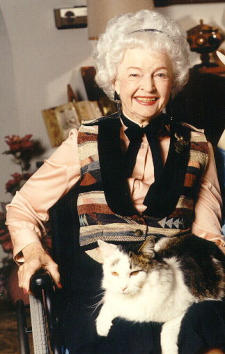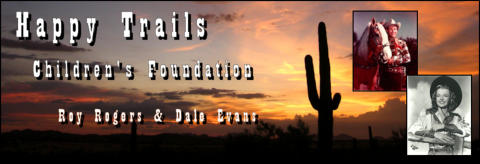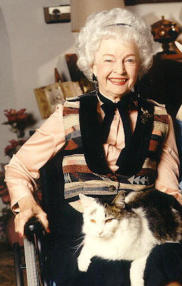
Copyright ©1999-2009 Roy Rogers. All rights reserved. Reproduction in whole or in part in any form or medium without express written permission of Roy
Rogers is prohibited.
Trigger, Bullet, Roy Rogers, Dale Evans, Roy Rogers Jr., Happy Trails Children's Foundation and RogersDale U.S.A. logo are trademarks of Roy Rogers.
"Disclaimer - Privacy Policy"
.
The Happy Trails Children's Foundation is a nonprofit/public benefit corporation, and it is organized under the nonprofit public benefit corporation law
for charitable purposes. All donations are fully tax deductible! The tax exempt status for the foundation (a 501c(3)) California public benefit corporation.
The employer tax identification number for this foundation is 95-3872257.
Dale Evans, known to millions of fans throughout the world as the Queen of
the West, passed away quietly in her sleep, surrounded by her family singing
gospel songs and hymns, on Wednesday, February 7, 2001. She was 88 years
old and had been in and out of the hospital numerous times in recent months,
suffering from congestive heart failure. Dale, the widow of legendary western
film star, Roy Rogers, was born Frances Octavia Smith in Uvalde, TX on October
31, 1912.
She began performing at a very early age, singing gospel solos in church. When
she was 7, her family moved to Osceola, AR. She was a very bright child and
progressed rapidly through school, skipping several grades. Mature for her age,
Dale eloped at 14, had a son at 15, and was divorced by the age of 16. She
then attended business school in Memphis, TN, and got a job with a local
insurance company. Her boss heard her singing one day and promptly put her
on a local radio program. In 1931, the young singer got a better job on a radio
station in Louisville, KY, using the stage name Marion Lee. A station executive
changed her “on air” name to Dale Evans. She later moved to Dallas, TX to be
the featured female vocalist on a popular radio station’s morning show. While
there, she married R. Dale Butts, a pianist and arranger she had known in
Louisville. Moving to Chicago, Butts landed a job as a composer-arranger with
NBC and Dale got a job singing with the Jay Mills orchestra. Within a short time,
she was hired as lead vocalist with the popular Anson Weeks Orchestra, and
spent a year touring the country with them. With a successful singing career,
Hollywood beckoned. After a screen test, she was signed to a one-year contract
by 20th Century Fox at $400 per week. Her short career there consisted of two
brief walk-on roles. She then became the featured vocalist on the “Chase and Sanborn Hour” radio show starring Edgar
Bergen and Charlie McCarthy. In 1942, she signed a contract with Republic Pictures, appearing in various roles in a half
dozen films including a song and dance scene in the John Wayne film, In Old Oklahoma (1943).
In 1944, Herbert J. Yates, president of Republic Pictures, cast her in a leading role opposite Roy Rogers in The Cowboy
and the Senorita. Dale really didn’t want to be in westerns. She had her heart set on appearing in musicals. Little did
she know they would be musical westerns! Even though hugely successful in these films, Dale rebelled at being
typecast in westerns. The continuing conflict in personal schedules between Dale and her husband, Butts, took a toll on
the marriage and they divorced in 1945.
Being from Texas, everyone assumed she could ride, but that was not the case. She learned to ride on the set, with help
from Roy and the wranglers, eventually becoming a darned good horsewoman! Dale went on to appear in 28 Republic
features with Roy, followed by 100 episodes of the Roy Rogers Show on TV from 1951 to 1957. They later had a variety
series and a number of specials on television. During this time, they continued to tour making personal appearances at
stage shows, rodeos and state fairs throughout the country.
While waiting on horseback to enter the arena at a rodeo in Chicago, Roy proposed to Dale, and then galloped into the
arena before she could say no. They were married in a blizzard on New Year’s Eve 1947 at a friend’s ranch in
Oklahoma. Roy’s wife Arline, had died of an embolism a week after Roy Rogers, Jr. was born in 1946. The marriage of
Rogers and Evans proved a long and happy one.
After her conversion to Christianity, about the time she and Roy married, Evans became a popular speaker and tireless
volunteer with Christian and charitable organizations. She had her own long-running television show on TBN. She
wrote more than 20 inspirational books, including the best seller, Angel Unaware; a book devoted to little Robin, the only
child that Roy and Dale had together. Robin was a Down’s syndrome baby that died at two years of age. Other
challenges to her great faith came when Debbie, an adopted Korean American girl, died in a church bus crash at the age
of 12, followed by the death of Sandy, an adopted son, while serving in the Army in Germany.
Dale was a very talented individual. She wrote many songs, including the couple’s theme song, “Happy Trails.” Other
hit songs included, “Ah ha, San Antone” and “The Bible Tells me So.”
Roy and Dale moved to Apple Valley, CA in 1965 and opened the Roy Rogers and Dale Evans Museum there in 1966.
In 1976, they moved the museum to a location adjacent to the freeway in Victorville. The museum moved one final time
to Branson, MO in 2003 and then closed for good at the end of 2009.
“Roy and Dale spent a lifetime devoted to children, especially children at-risk. Dale was an inspiration to all of us at the
Happy Trails Children’s Foundation and we miss her,” stated Joel Dortch, Executive Director.
Dale Evans is survived by her son by her first marriage, Tom Fox; adopted stepdaughter Cheryl Barnett; adopted
daughter Linda Lou Johnson; adopted son Roy “Dusty” Rogers, Jr.; adopted daughter Dodie Patterson; and foster
daughter Marion Swift; 16 grandchildren; and more than 30 great-grandchildren.



By Joel “Dutch” Dortch


Copyright ©1999-2009 Roy Rogers. All rights reserved. Reproduction in whole or in part in any
form or medium without express written permission of Roy Rogers is prohibited.
Trigger, Bullet, Roy Rogers, Dale Evans, Roy Rogers Jr., Happy Trails Children's Foundation
and RogersDale U.S.A. logo are trademarks of Roy Rogers.
"Disclaimer - Privacy Policy"
.
The Happy Trails Children's Foundation is a nonprofit/public benefit corporation, and it is
organized under the nonprofit public benefit corporation law
for charitable purposes. All donations are fully tax deductible! The tax exempt status for the
foundation (a 501c(3)) California public benefit corporation.
The employer tax identification number for this foundation is 95-3872257.
Dale Evans, known to millions of fans
throughout the world as the Queen of the
West, passed away quietly in her sleep,
surrounded by her family singing gospel
songs and hymns, on Wednesday,
February 7, 2001. She was 88 years old
and had been in and out of the hospital
numerous times in recent months,
suffering from congestive heart failure.
Dale, the widow of legendary western film
star, Roy Rogers, was born Frances
Octavia Smith in Uvalde, TX on October
31, 1912.
She began performing at a very early age,
singing gospel solos in church. When she
was 7, her family moved to Osceola, AR.
She was a very bright child and
progressed rapidly through school, skipping several grades. Mature for
her age, Dale eloped at 14, had a son at 15, and was divorced by the
age of 16. She then attended business school in Memphis, TN, and got
a job with a local insurance company. Her boss heard her singing one
day and promptly put her on a local radio program. In 1931, the young
singer got a better job on a radio station in Louisville, KY, using the stage
name Marion Lee. A station executive changed her “on air” name to Dale
Evans. She later moved to Dallas, TX to be the featured female vocalist
on a popular radio station’s morning show. While there, she married R.
Dale Butts, a pianist and arranger she had known in Louisville. Moving
to Chicago, Butts landed a job as a composer-arranger with NBC and
Dale got a job singing with the Jay Mills orchestra. Within a short time,
she was hired as lead vocalist with the popular Anson Weeks Orchestra,
and spent a year touring the country with them. With a successful
singing career, Hollywood beckoned. After a screen test, she was signed
to a one-year contract by 20th Century Fox at $400 per week. Her short
career there consisted of two brief walk-on roles. She then became the
featured vocalist on the “Chase and Sanborn Hour” radio show starring
Edgar Bergen and Charlie McCarthy. In 1942, she signed a contract with
Republic Pictures, appearing in various roles in a half dozen films
including a song and dance scene in the John Wayne film, In Old
Oklahoma (1943).
In 1944, Herbert J. Yates, president of Republic Pictures, cast her in a
leading role opposite Roy Rogers in The Cowboy and the Senorita. Dale
really didn’t want to be in westerns. She had her heart set on appearing
in musicals. Little did she know they would be musical westerns! Even
though hugely successful in these films, Dale rebelled at being typecast
in westerns. The continuing conflict in personal schedules between Dale
and her husband, Butts, took a toll on the marriage and they divorced in
1945.
Being from Texas, everyone assumed she could ride, but that was not
the case. She learned to ride on the set, with help from Roy and the
wranglers, eventually becoming a darned good horsewoman! Dale went
on to appear in 28 Republic features with Roy, followed by 100 episodes
of the Roy Rogers Show on TV from 1951 to 1957. They later had a
variety series and a number of specials on television. During this time,
they continued to tour making personal appearances at stage shows,
rodeos and state fairs throughout the country.
While waiting on horseback to enter the arena at a rodeo in Chicago, Roy
proposed to Dale, and then galloped into the arena before she could say
no. They were married in a blizzard on New Year’s Eve 1947 at a
friend’s ranch in Oklahoma. Roy’s wife Arline, had died of an embolism a
week after Roy Rogers, Jr. was born in 1946. The marriage of Rogers
and Evans proved a long and happy one.
After her conversion to Christianity, about the time she and Roy married,
Evans became a popular speaker and tireless volunteer with Christian
and charitable organizations. She had her own long-running television
show on TBN. She wrote more than 20 inspirational books, including the
best seller, Angel Unaware; a book devoted to little Robin, the only child
that Roy and Dale had together. Robin was a Down’s syndrome baby
that died at two years of age. Other challenges to her great faith came
when Debbie, an adopted Korean American girl, died in a church bus
crash at the age of 12, followed by the death of Sandy, an adopted son,
while serving in the Army in Germany.
Dale was a very talented individual. She wrote many songs, including
the couple’s theme song, “Happy Trails.” Other hit songs included, “Ah
ha, San Antone” and “The Bible Tells me So.”
Roy and Dale moved to Apple Valley, CA in 1965 and opened the Roy
Rogers and Dale Evans Museum there in 1966. In 1976, they moved the
museum to a location adjacent to the freeway in Victorville. The museum
moved one final time to Branson, MO in 2003 and then closed for good at
the end of 2009.
“Roy and Dale spent a lifetime devoted to children, especially children at-
risk. Dale was an inspiration to all of us at the Happy Trails Children’s
Foundation and we miss her,” stated Joel Dortch, Executive Director.
Dale Evans is survived by her son by her first marriage, Tom Fox;
adopted stepdaughter Cheryl Barnett; adopted daughter Linda Lou
Johnson; adopted son Roy “Dusty” Rogers, Jr.; adopted daughter Dodie
Patterson; and foster daughter Marion Swift; 16 grandchildren; and more
than 30 great-grandchildren.


By Joel “Dutch” Dortch






































